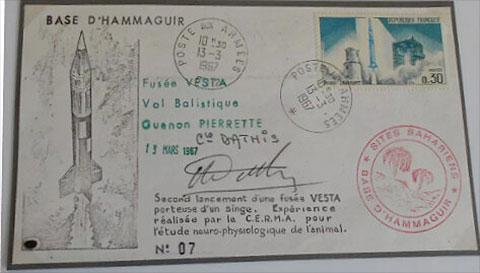Space Cover 763: Monkey Pierrette to SpaceOver thirty non-human primates have flown in the space programs of the United States, France, and Soviet Union/Russia.
France's Centre d'Enseignement et de Recherches de Médecine Aéronautique (C.E.R.M.A.) launched a pig-tailed macaque named Martine on a Vesta rocket on March 7, 1967, and another named Pierrette on March 13. These suborbital flights reached 151 miles and 145 miles, respectively. Martine became the first monkey to survive more than a couple of hours after flying above the international definition of the edge of space. (Note: Ham and Enos, launched earlier by the United States, were chimpanzees.) France concluded their biological payload research at the national level with these flights.
The cover pictured above is for the launch of Pierrette with an Army Postmark on March 13.
Pierrette launched aboard the fourth launch of a Vesta rocket from Base Hammaguir in Algeria. The purpose of the flight was to carry out biological experiments as Pierrette was conditioned before this flight to respond to light stimuli by pulling on 5 joysticks in a specific sequential manner and receiving a reward for each correct gesture. The entire flight was a success. It has been noted that she had allowed herself a few moments of sleep during the first phases of takeoff before fulfilling her role perfectly. Pierrette was found 25 minutes after takeoff and lived for many years after the flight.
Base Hammaguir, also known as CIEES (Centre Interarmées d'Essais d'Engins Spéciaux) Hammaguir, was a rocket launch site near Hammaguir, Algeria, named and used by France for suborbital and orbital launches between 1947 and 1967.
Covers from Base Hammaguir exist for some of the flights and many of them have the Base Hammaguir rubber stamp seen on this cover.












